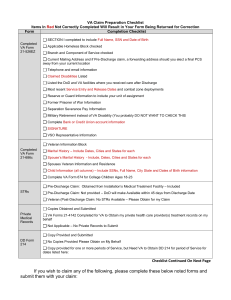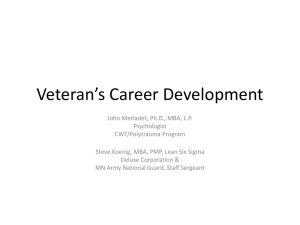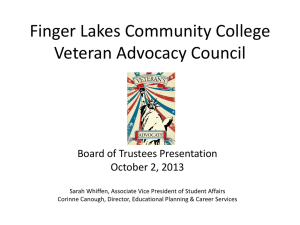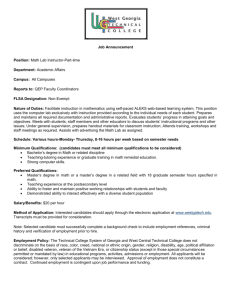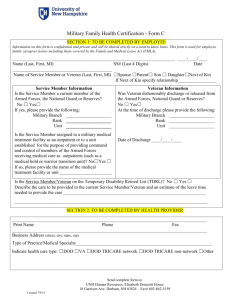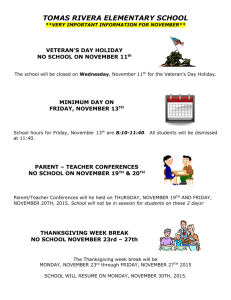Guide for Site Visits - Montgomery County Chamber of Commerce
advertisement
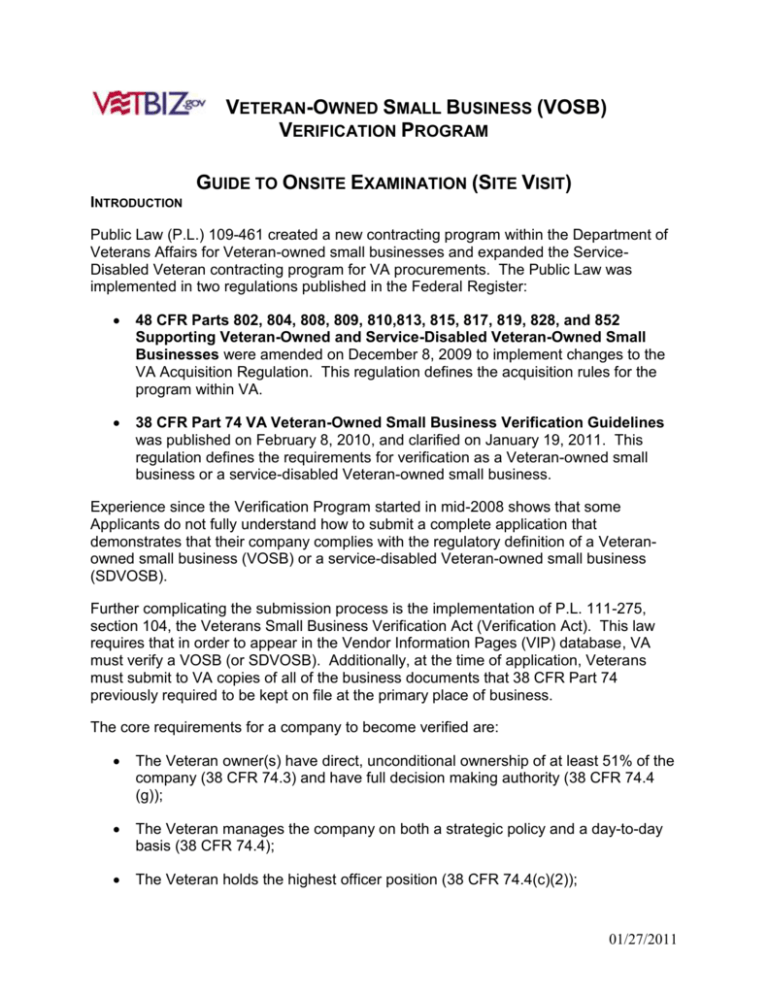
VETERAN-OWNED SMALL BUSINESS (VOSB) VERIFICATION PROGRAM GUIDE TO ONSITE EXAMINATION (SITE VISIT) INTRODUCTION Public Law (P.L.) 109-461 created a new contracting program within the Department of Veterans Affairs for Veteran-owned small businesses and expanded the ServiceDisabled Veteran contracting program for VA procurements. The Public Law was implemented in two regulations published in the Federal Register: 48 CFR Parts 802, 804, 808, 809, 810,813, 815, 817, 819, 828, and 852 Supporting Veteran-Owned and Service-Disabled Veteran-Owned Small Businesses were amended on December 8, 2009 to implement changes to the VA Acquisition Regulation. This regulation defines the acquisition rules for the program within VA. 38 CFR Part 74 VA Veteran-Owned Small Business Verification Guidelines was published on February 8, 2010, and clarified on January 19, 2011. This regulation defines the requirements for verification as a Veteran-owned small business or a service-disabled Veteran-owned small business. Experience since the Verification Program started in mid-2008 shows that some Applicants do not fully understand how to submit a complete application that demonstrates that their company complies with the regulatory definition of a Veteranowned small business (VOSB) or a service-disabled Veteran-owned small business (SDVOSB). Further complicating the submission process is the implementation of P.L. 111-275, section 104, the Veterans Small Business Verification Act (Verification Act). This law requires that in order to appear in the Vendor Information Pages (VIP) database, VA must verify a VOSB (or SDVOSB). Additionally, at the time of application, Veterans must submit to VA copies of all of the business documents that 38 CFR Part 74 previously required to be kept on file at the primary place of business. The core requirements for a company to become verified are: The Veteran owner(s) have direct, unconditional ownership of at least 51% of the company (38 CFR 74.3) and have full decision making authority (38 CFR 74.4 (g)); The Veteran manages the company on both a strategic policy and a day-to-day basis (38 CFR 74.4); The Veteran holds the highest officer position (38 CFR 74.4(c)(2)); 01/27/2011 The Veteran should be the highest compensated employee unless there is a logical explanation otherwise submitted by the Veteran as to how taking a lower salary than other employee(s) helps the business (38 CFR 74.4 (g) (3)); and The Veteran has the managerial experience of the extent and complexity needed to run the company The Applicant bears the burden of proof of adequately establishing its claimed status. The January 19, 2011 Federal Register Notice clarified that a Veteran is not necessarily limited to having one company verified, and all Veteran owners do not necessarily have to work 40 or more hours per week at each verified company. The January 19 clarification, however, did not change the requirement for the company to comply with 38 CFR Part 74 in order to be verified, which still includes the requirement that an eligible Veteran owner who manages the company must devote full-time to the business during the normal working hours of the firm. This Guideline is intended to assist Applicants in complying with the regulatory requirements in 38 CFR Part 74 in order to apply for verification. Whenever this Guideline appears inconsistent with 38 CFR Part 74 VA Veteran-Owned Small Business Verification Guidelines, the language in 38 CFR Part 74 applies. OVERVIEW OF THE VERIFICATION PROCESS The Verification Process consists of three steps: The Veteran applies to have a company verified by entering ownership information into VIP and signing VA Form 0877 electronically in their VIP registration. A list of required business and financial documents by business type is posted on the VetBiz.gov Web site. In the near future, the Vendor Information Pages database will be modified to permit owners to directly upload their documents when registering or updating their profile. Until that change is available, owners must submit their documentation via the Verification Document Submission Web Portal at https://uploads.va.gov/vetbiz/. Once all the owners have completed the electronic signature, VA verifies the Veteran status of each Veteran owner in VA’s Beneficiary Identification Records Locator Subsystem (BIRLS) database. The Veteran status of most Applicants is verified on the first query and the application then moves on to Examination. In a few cases, the Applicant’s Veteran status is not verifiable and a letter is sent to the Applicant explaining how the Veteran can get their BIRLS record corrected. Once an Applicant’s Veteran status is verified, Veteran ownership and control is verified by examining information databases and business and financial documents submitted by the Applicant. Some of the Examination process is 2 1/31/2011 being electronically integrated to the VIP registration process, but at this time Examination is a manual procedure. In some cases, ownership and control issues remain after the Examination is completed. In these instances, a site visit is scheduled with the Applicant, in which an Examiner will visit the Applicant’s place of business to conduct interviews and additional reviews. It is not easy to become verified, nor is it an entitlement. Applicants must conform to the requirements of 38 CFR Part 74 in order to be verified. A company is selected for a site visit in order to provide the Applicant the opportunity to provide additional information and clarification of issues that would otherwise result in a denial of their application for verification as a VOSB or SDVOSB. COMPONENTS OF A SUCCESSFUL SITE VISIT 1. Schedule a firm date and prepare for the Site Visit. Talk with the Examiner to learn any specific requirements and schedule a mutually agreeable date. Update your registration in the Vendor Information Pages (VIP) database. Once the visit is scheduled, it is not easy to reschedule. In many cases the Examiner has made travel arrangements and/or may have other visits scheduled the same week. Typically, VA will not approve the application unless the site visit is completed successfully and demonstrates that the Applicant fully conforms to the regulatory requirements in 38 CFR Part 74. The Veteran must be present during the site visit. 2. Read 38 CFR Part 74 if you are not sure of the specific ownership and control requirements for which the Applicant must conform. Applications that do not conform to the requirements of Veteran status, ownership, and control in 38 CFR Sections 74.3 and 74.4 will be denied. In summary, these are: The Veteran has unconditional direct ownership; The Veteran holds the highest officer position and is the highest paid employee, unless there is an reasonable explanation submitted by the Veteran as to how taking a lower salary than other employee(s) helps the business; 3 1/31/2011 The Veteran manages the company on both a strategic policy and a day-today basis; and Non-Veterans do not control the company. The Veteran has the managerial experience of the extent and complexity needed to run the company 3. The Applicant must be present during the visit. Schedule the visit such that the Veteran Applicant will be present during the visit. The Examiner may wish to interview all the company owners during the site visit. 4. Respond quickly and completely to any requests for information. Many site visits are performed by VA support contractors. If the Examiner requests additional documents, processing stops until they receive those documents. If the Applicant does not respond, VA can deny the application based upon a lack of supporting information. 4 1/31/2011
